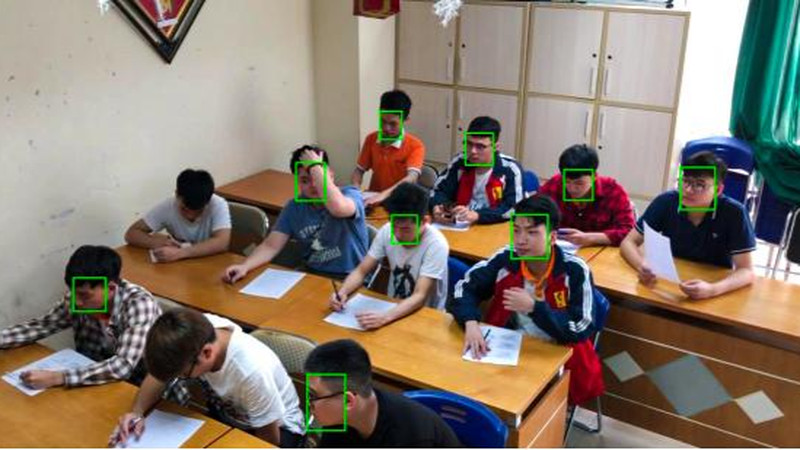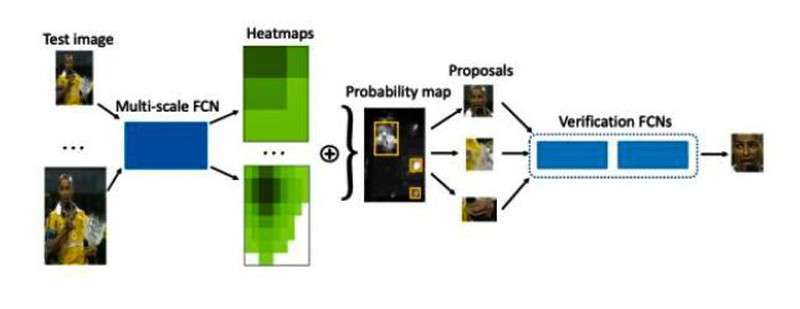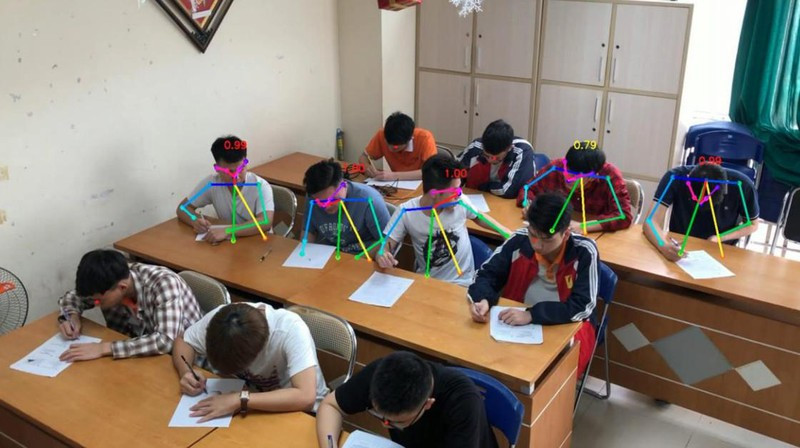Students of Hanoi University of Industry study the application of ‘problems’ to detect exam cheating
Students of Hanoi University of Industry study the application of ‘problems’ to detect exam cheating
(PLVN) – From some previous research results on image processing, face detection, recognition, human skeleton estimation and abnormal behavior recognition, a group of students from the Faculty of Information Technology (IT) Hanoi University of Industry continues to research and complete the project “Automatically detect abnormal behavior in video based on different features, applied to exam cheating detection problem”.


A group of students from Hanoi University of Industry research and apply to the problem of detecting exam cheating. (Pictured).
The research team consists of 5 members: Hoang Tung Lam, Bui Ngoc Hai, Nguyen Duc Linh – Student of Computer Science class 1, K12; Dao Le Huy – Student of Computer Science class 2, K12 and Phan Thanh Trung – Student of Information Technology class 4, K12. The instructor is Dr. Vu Viet Thang – Faculty of IT.


Dr. Vu Viet Thang discussed online with the research team.
Through the research, the above group of students realized that, in recent years, many advances in the field of artificial intelligence, machine learning and deep learning have provided solutions to recognition problems such as: object recognition, handwriting recognition, face recognition, shape recognition, voice recognition, etc. with very high accuracy. These technologies are fully capable of being applied to solving problems in the education industry, especially detecting cheating in exams.
The abnormal behavior detection system applied to the exam fraud detection problem can help the examiner to easily find students with abnormal behavior, helping to improve the transparency of the exam, giving feedback. accurately reflect the test results of the candidates after each exam.


Multi-Scale Cascade Fully Convolutional Network for Face Detection model application group.
From taking advantage of previous studies on image processing, face detection, face recognition, human skeleton estimation and abnormal behavior recognition, the above group of students completed the topic “Automatically detect Abnormal behavior in video based on different types of features, applied to exam cheating detection problem”.
Specifically, the group has studied, researched and installed advanced algorithms related to face detection, face recognition, human skeleton estimation; building and applying a new dataset for the exam cheating problem. In addition, the team designed a deep learning model for the problem of abnormal behavior recognition and combined the above models to build an exam cheating detection
system.

Face recognition problem, facial landmark recognition (Face Detection, Facial Landmark Estimation).
Hệ thống phát hiện hành vi gian lận cho độ chính xác cao, trên 97% với các hành vi rõ ràng như quay ngang, quay ngửa, nhổm lên, liếc bài, làm việc riêng dưới gầm bàn và khả năng nhận diện khuôn mặt của thí sinh có hành vi gian lận cũng cho độ chính xác rất cao lên đến 98%.
Ngoài ra, nhóm nghiên cứu này đang hoàn thành những kết quả nghiên cứu cuối cùng, hướng đến xây dựng hệ thống phát hiện gian lận thi cử có thể ứng dụng trực tiếp tại các phòng thi thông qua hệ thống camera giám sát.


Test results of exam cheating detection problem.
Group leader Hoang Tung Lam shared: “The implementation of the topic research also contributes to promoting the spirit of scientific research for the group members as well as equipping them with more in-depth knowledge and knowledge. helping each member easily grasp career opportunities after graduation”.
Dr. Vu Viet Thang – IT faculty commented: “Currently, many scientific research topics of students have not high practical application. Therefore, it is necessary to improve the practical applicability of scientific research among students at the Faculty of Information Technology in particular and Hanoi University of Industry in general, especially in the context of strong digital transformation. as strong as it is today”.
PV
CÁC TIN LIÊN QUAN
- (Tiếng Việt) Quản lý nhân sự xây dựng như thế nào?
- (Tiếng Việt) Kinh nghiệm lựa chọn phần mềm chấm công cho máy chấm công vân tay
- (Tiếng Việt) Giao việc là gì? Cách để ủy quyền và giao việc hiệu quả
- What are SLAs? Businesses that want to be sustainable cannot do without SLA!
- Ronald Jack hands over Smart Human Resource Management 4.0 solution to the Vegetarian Restaurant chain
- HOW TO BECOME A GOOD HUMAN RESOURCE ADMINISTRATIVE?
- What is IoT? Application of IoT in business and life
- AI detects shipwrecks from the air
- Top 7 best task management software today
- How to still have a chance to get promoted while working from home







